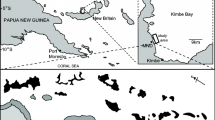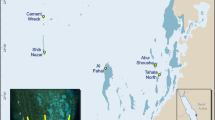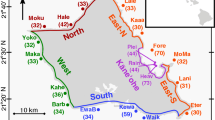Abstract
A rapid benthic line-transect survey method for use by non-specialist observers is described. At both Davies Reef (mid-continental shelf) and Myrmidon Reef (outer-continental shelf) in the central Great Barrier Reef a set of 6 sites of varying depths on the reef flat, crest and slope were sampled using this method. At least 10 contiguous 10 m transects were made at each site. Benthic organisms were recorded as life forms with categories based on both high level taxa and morphologies, and including scleractinian corals, alcyonarians, sponges, algae and others. Percentage cover data for 19 benthic categories are presented for all sites. Coral cover on both reefs is high on the crest and slope but low on the reef flat. At all sites the cover of soft corals and sponges is much less than cover of hard corals and algae. Abundances of soft corals and sponges increase with depth. Analysis of gaps between hard corals show that many colonies grow close to each other (<1 cm)even when total coral cover is low.
Similar content being viewed by others
References
Babcock RC (1984) Reproduction and distribution of two species of Goniastrea (Scleractinia) from the Great Barrier Reef province. Coral Reefs 2:187–195
Bak RPM, Luckhurst BE (1980) Constancy and change in coral reef habitats along depth gradients at Curacao. Oecologia 47:145–155
Bak RPM, Termaat RM, Deckerr R (1982) Complexity of coral interactions: Influence of time, location of interaction and epifauna. Mar Biol 69:215–222
Banner AH, Bailey JH (1970) The effects of urban pollution upon a coral reef system, a preliminary report. Hawaii Institute of Marine Biology, University of Hawaii, Tech Report 25, 66 pp
Barnes J, Bellamy DJ, Jones DJ, Whitton BA, Drew EA, Kenyon L, Lythgoe JN, Rosen BR (1971) Morphology and ecology of the reef front of Aldabra. Symp Zool Soc Lond 28:87–114
Benayahu Y, Loya Y (1977) Space partitioning by stony corals, soft corals and benthic algae on the coral reefs of the northern Gulf of Eilat (Red Sea). Helgol Wiss Meeresunters 30:362–382
Benayahu Y, Loya Y (1981) Competition for space among coral-reef sessile organisms at Eilat, Red Sea. Bull Mar Sci 31:514–522
Borowitzka MA (1981) Algae and grazing in coral reef ecosystems. Endeavour 5:99–106
Bothwell AM (1983) Toppling, contact overgrowth and extracoelenteric digestion among corals and the intermediate disturbance hypothesis. Aust Coral Reef Soc Annu Sci Meeting, pp 16–21
Bradbury RH, Loya Y (1978) A heuristic analysis of spatial patterns of hermatypic corals at Eilat, Red Sea. Am Nat 112:493–507
Bradbury RH, Young PC (1983) Coral interactions and community structure: an analysis of spatial pattern. Mar Ecol Prog Ser 11:265–275
Bradbury RH, Loya Y, Reichelt RE, Williams WT (1986) Patterns in the structural typology of benthic communities on two coral reefs of the central Great Barrier Reef. Coral Reefs 4:161–167
Dahl AL (1981) Monitoring coral reefs for urban impact. Bull Mar Sci 31:544–551
DeVantier LM, Barnes GR, Daniel PA, Johnson DB (1985) Studies in the assessment of coral reef ecosystems. 1. Assessment protocol. Australian Institute of Marine Science, Townville, 23 pp
Dinesen ZD (1983) Patterns in the distribution of soft corals across the central Great Barrier Reef. Coral Reefs 1:229–236
Done TJ (1982) Patterns in the distribution of coral communities across the central Great Barrier Reef. Coral Reefs 1:95–107
Done TJ (1983) Coral zonation: its nature and significance. In: Barnes DJ (ed) Perspectives on coral reefs, Australian Institute of Marine Science, Townsville, pp 107–147
Done TJ, Kenchington RA, Zell LD (1981) Rapid, large area, reef resource surveys using a manta board. Proc 4th Int Coral Reef Symp 1:299–308
Drew EA (1977) A photographic survey down the seaward reef-front of Aldabra atoll. Atoll Res Bull 193:1–7
Drew EA (1983) Halimeda biomass, growth rates and sediment generation on reefs in the central Great Barrier Reef Province. Coral Reefs 2:101–110
Fishelson L (1970) Littoral fauna of the Red Sea: the population of non-scleractinian anthozoans of shallow waters of the Red Sea (Eilat). Mar Biol 6:106–116
Hatcher BG (1981) The interaction between grazing organisms and the epilithic algal community of a coral reef: a quantitative assessment. Proc 4th Int Coral Reef Symp 2:515–524
Hatcher BG (1983) Grazing on coral reef ecosystems. In: Barnes DJ (ed) Perspectives on coral reefs. Australian Institute of Marine Science, Townsville, pp 164–179
Kohn AJ (1983) Microhabitat factors affecting abundance and diversity of Conus on coral reefs. Oecologia 60:293–301
Lang J (1973) Interspecific aggression by scleractinian corals. 2. Why the race is not only to the swift. Bull Mar Sci 23-260–279
Lawrence JM (1975) On the relationships between marine plants and sea urchins. Oceanogr Mar Biol Ann Rev 13:213–286
Lewis JB (1970) Spatial distribution and pattern of some Atlantic reef corals. Nature 227:1158–1159
Lieberman M, John DM, Lieberman D (1984) Factors influencing algal spieces assemblages on reef and cobble substrata off Ghana. J Exp Mar Biol Ecol 75:129–143
Littler MM, Arnold KE (1982) Primary productivity of marine macroalgal functional-form groups from southwestern North America. J Phycol 18:207–311
Littler MM, Taylor PR, Littler DS (1983) Algal resistance to herbivory on a Caribbean barrier reef. Coral Reefs 2:111–118
Loya Y (1978) Plotless and transect methods. In: Stoddart DR, Johannes RE (eds) Coral reefs: research methods. UNESCO, pp 197–217
Menge BA (1972) Foraging strategy of a starfish in relation to actual prey availability and environmental predictability. Ecol Monogr 42:25–50
Morrisey J (1980) Community structure and zonation of macroalgae and hermatypic corals on a fringing reef flat of Magnetic Island (Queensland, Australia). Aqua Bot 8:91–139
Morton J (1974) The coral reefs of the British Solomon Islands: a comparative study of their composition and ecology. Proc 2nd Int Coral Reef Symp 2:31–53
Ogden JC (1976) Some aspect of herbivore-plant relationships on Caribbean reefs and seagrass beds. Aqua Bot 2:103–116
Potts DC (1977) Suppression of coral populations by filamentous algae within damselfish territories. J Exp Mar Biol Ecol 28:207–210
Randall JE (1961) Overgrazing of algae by herbivorous marine fishes. Ecology 42:812
Reichelt RE (1982) Space: a non-limiting resource in the niches of some abundant coral reef gastropods. Coral Reefs 1:3–11
Reichelt RE, Bradbury RH (1984) Spatial patterns in coral reef benthos: multiscale analysis of sites from three oceans. Mar Ecol Prog Ser 17:251–257
Sammarco PW (1983) Effects of fish grazing and damselfish territoriality on coral reef algae. I. Algal community structure. Mar Ecol Prog Ser 13:1–14
Sammarco PW, Levinton JS, Odgen JC (1974) Grazing and control of coral reef community structure by Diadema antillarum Philippi (Echinodermata: Echinoidea): A preliminary study. J Mar Res 32:47–53
Sheppard CRC (1979) Interspecific aggression between reef corals with reference to their distribution. Mar Ecol Prog Ser 1:237–247
Sheppard CRC (1981) “Reach” of aggressively interacting corals, and relative importance of interactions at different depths. Proc 4th Int Coral Reef Symp 2:363–368
Sheppard CRC (1982) Coral populations on reef slopes and their major controls. Mar Ecol Prog Ser 7:83–115
Steneck RS, Watling L (1982) Feeding capabilities and limitation of herbivorous molluscs: a functional group approach. Mar Biol 62:299–319
Stephenson W, Searles RB (1960) Experimental studies on the ecology of intertidal environments at Heron Island. Aust J Mar Freshwat Res 11:241–267
Veron JEN, Pichon M (1976) Scleractinia of eastern Australia. I. Families Thamnasteriidae, Astrocoeniidae, Pocilloporidae. Aust Inst Mar Sci Monogr Ser (Australian Govt Publ Service, Canberra), 86 pp
Veron JEN, Wallace CC (1984) Scleractinia of eastern Australia. V. Family Acroporidae. Aust Inst Mar Sci Monogr Ser (ANU Press, Canberra), 485 pp
Vine PJ (1974) Effects of algal grazing and aggressive behaviour of the fishes, Pomacentrus lividus and Acanthurus sohal on coral reef ecology. Mar Biol 24:131–136
Webb LJ, Tracey JG, Williams WT, Lance GM (1970) Studies in the numerical analysis of complex rain forest communities. V. A comparison of the properties of floristic and physiognomic-structure data. J Ecol 58:203–32
Webb LJ, Tracey JG, Williams WT (1976) The value of structural features in tropical forest typology. Aust J Ecol 1:3–28
Webb LJ, Tracey JG, Williams WT (in press) Australian tropical forests in a southeast Asian context: a numerical method for site comparison. In: Proceedings of a symposium on Ecology of the wet-dry tropics. Proc Ecol Soc Aust 13, 1984
Wilkinson CR (1981) Significance of sponges with cyanobacterial symbionts on Davies Reef, Great Barrier Reef. Proc 4th Int Coral Reef Sym 2:705–712
Wilkinson CR (1983) Net primary productivity in coral reef sponges. Science 219:410–412
Wilkinson CR, Trott LA (1983) Significance of photosynthetic symbioses across the central Great Barrier Reef. In: Baker JT (eds) Proceedings of the Inaugural Great Barrier Reef Conference. James Cook University, Townsville, p 263
Williams DMcB (1982) Patterns in the distribution of fish communities across the central Great Barrier Reef. Coral Reefs 1:35–43
Author information
Authors and Affiliations
Rights and permissions
About this article
Cite this article
Reichelt, R.E., Loya, Y. & Bradbury, R.H. Patterns in the use of space by benthic communities on two coral reefs of the Great Barrier Reef. Coral Reefs 5, 73–79 (1986). https://doi.org/10.1007/BF00270355
Accepted:
Issue Date:
DOI: https://doi.org/10.1007/BF00270355




